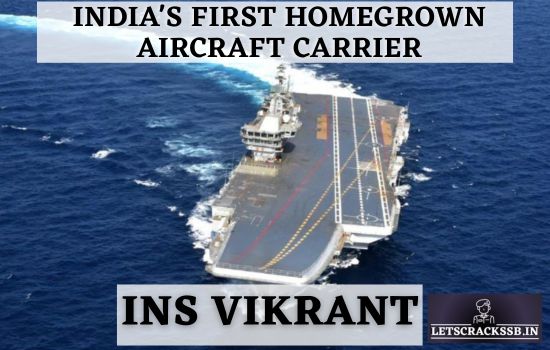Indigenous Aircraft Carrier 1 (IAC-1) INS Vikrant is a remarkable achievement for the Indian Navy, as it is India’s first homegrown aircraft carrier. It was launched on 12 August 2013 by the then Defence Minister A.K. Antony, and after almost eight years of construction, it was commissioned into the Indian Navy on 2nd September 2022.
This aircraft carrier is a proud symbol of India’s rapidly expanding military capabilities, and it represents a major leap forward in the country’s defence preparedness. With the INS Vikrant, India has joined a select group of nations with the capability to design, build and operate such sophisticated naval vessels.
What is Aircraft Carrier?
An aircraft carrier is a type of warship that serves as a mobile airbase for military aircraft, facilitating combat operations. These ships are typically the largest in a navy’s fleet and can measure up to 1,000 feet in length with a displacement of tens of thousands of tons.
Aircraft carriers can deploy and launch various types of aircraft, including fighter jets, attack planes, and reconnaissance aircraft, as well as helicopters. These vessels also have sophisticated radar and sensor systems that detect and track potential threats, including enemy aircraft.
The primary function of an aircraft carrier is to project military power in areas where permanent military bases are not available or feasible, allowing a navy to respond to changing situations and engage in offensive operations quickly. In addition, aircraft carriers can assist with humanitarian and disaster relief missions by transporting aid and supplies to affected areas.
Aircraft carriers are considered symbols of national power and prestige due to their size and capabilities. They are often used as a deterrent against potential adversaries and play a crucial role in naval warfare. The ships’ aircraft can engage targets at long distances and provide support to ground troops during military operations.
Indian Aircraft Carrier – INS Vikrant Specifications
The INS Vikrant has a displacement of 40,000 tonnes and is 262 meters long. It is powered by four General Electric LM2500 gas turbines, which can generate a combined power of 80 MW, enabling the vessel to achieve a maximum speed of over 28 knots. The ship has a crew of 1,600 personnel, including 160 officers and 1,440 sailors.
It is equipped with an advanced weapon and sensor suite, including a range of missiles, anti-aircraft guns, and torpedo launchers. The ship has the capability to carry up to 30 fixed-wing fighter aircraft, such as the indigenous Tejas Mk 2, and a range of helicopters, including the Russian Kamov Ka-31 and the American Sikorsky SH-60 Seahawk.
The INS Vikrant’s design incorporates advanced stealth features, including a reduced radar cross-section, making it difficult for enemy radar systems to detect the vessel. It also has a powerful air defence system, which includes a Barak-8 surface-to-air missile system, capable of engaging multiple airborne targets simultaneously.
Why do Military Vehicles have Unique Number Plates?
Why INS Vikrant is Important?
The INS Vikrant is a symbol of India’s growing military might and a testament to the country’s technological capabilities. The vessel is a result of a joint effort between the Indian Navy, the Defence Research and Development Organisation (DRDO), and several private and public sector companies. The construction of the INS Vikrant was undertaken by Cochin Shipyard Limited (CSL), one of the largest shipbuilding and maintenance facilities in India.
The INS Vikrant project has been a long and challenging journey for India, with several delays and cost overruns. The initial plan for the vessel was conceived in the 1980s, and the design was finalised in 1999. However, due to various technical and financial challenges, the project suffered significant delays and was eventually commissioned over a decade later than originally planned.
Despite the challenges, the INS Vikrant is a significant achievement for India, and it represents a major milestone in the country’s defence preparedness. With its advanced capabilities and cutting-edge technology, the vessel is poised to play a crucial role in India’s maritime security strategy, enhancing the country’s defence capabilities and bolstering its position as a regional power.
The INS Vikrant is also an important step towards India’s goal of achieving self-reliance in defence production. The vessel is a testament to the country’s growing expertise in the field of shipbuilding and its ability to design and manufacture complex defence systems. The project has also created significant employment opportunities and contributed to the development of a robust domestic defence industry.
Benefits of INS Vikrant to the Indian Navy
The INS Vikrant is India’s first indigenously built aircraft carrier, and it provides various benefits to the Indian Navy, including enhanced capabilities for maritime operations.
- The carrier can carry various fighter aircraft and helicopters, and it has an array of advanced sensors and weapons, making it a powerful platform for maritime operations. The aircraft carrier’s advanced capabilities enable it to undertake a range of operations, including surveillance, reconnaissance, and interdiction operations, improving India’s maritime security and deterring potential threats.
- The construction of the INS Vikrant was undertaken entirely in India, providing significant opportunities for the domestic defence industry and boosting India’s self-reliance in defence production. The project has created significant employment opportunities for thousands of people, including engineers, technicians, and labourers.
- With its advanced capabilities, the INS Vikrant can operate in different regions, projecting India’s power and influence and providing support to friendly nations during times of crisis, enhancing India’s diplomatic relations in the region. The carrier also provides an excellent platform for training naval personnel in different aspects of maritime operations, providing valuable experience that can be applied to other naval operations.
The carrier INS Vikrant provides various benefits to the Indian Navy, enhancing its capabilities, improving maritime security, boosting domestic defence production, creating employment opportunities, projecting regional power, and providing valuable training opportunities.
In conclusion, the Indigenous Aircraft Carrier 1 (IAC-1) INS Vikrant is a remarkable achievement for the Indian Navy and a significant milestone in India’s defence preparedness. The vessel’s advanced capabilities and cutting-edge technology make it an important addition to India’s maritime security strategy, and its construction represents a significant step towards achieving self-reliance in defence production. The INS Vikrant is a proud symbol of India’s growing military might and regional power, and it is poised to play a crucial role in enhancing India’s defence capabilities and bolstering its position as a key player in the region.
Must Read
- NDA Study Material – Which is the best Source for 2023
- What is the difference between NDA and TES?
- Army Medical Test | Know the Full Procedure of the SSB Medical Test
What is INS Vikrant?
INS Vikrant is India’s first indigenously built aircraft carrier, commissioned by the Indian Navy. It is a significant achievement for the Indian Navy and represents the country’s growing technological and manufacturing prowess.
Who built INS Vikrant?
The construction of INS Vikrant was undertaken by Cochin Shipyard Limited (CSL) in Kochi, India.
What is the role of INS Vikrant?
The primary role of INS Vikrant is to provide air support for naval operations and to enhance the Indian Navy’s capabilities in securing its maritime interests. It can undertake a range of maritime operations, including surveillance, reconnaissance, and interdiction operations.
What are the specifications of INS Vikrant?
INS Vikrant has a length of 262 meters, a beam of 62 meters, and a displacement of 40,000 tons. It can carry up to 30 fighter aircraft and helicopters and is equipped with an array of advanced sensors and weapons.
When was INS Vikrant commissioned?
INS Vikrant was commissioned on 16th August 2022, after several years of construction and testing.
Is INS Vikrant operational?
Yes, INS Vikrant is now operational and has been commissioned by the Indian Navy.
Can INS Vikrant operate in different regions?
Yes, with its advanced capabilities, INS Vikrant can operate in different regions, projecting India’s power and influence in the region.


